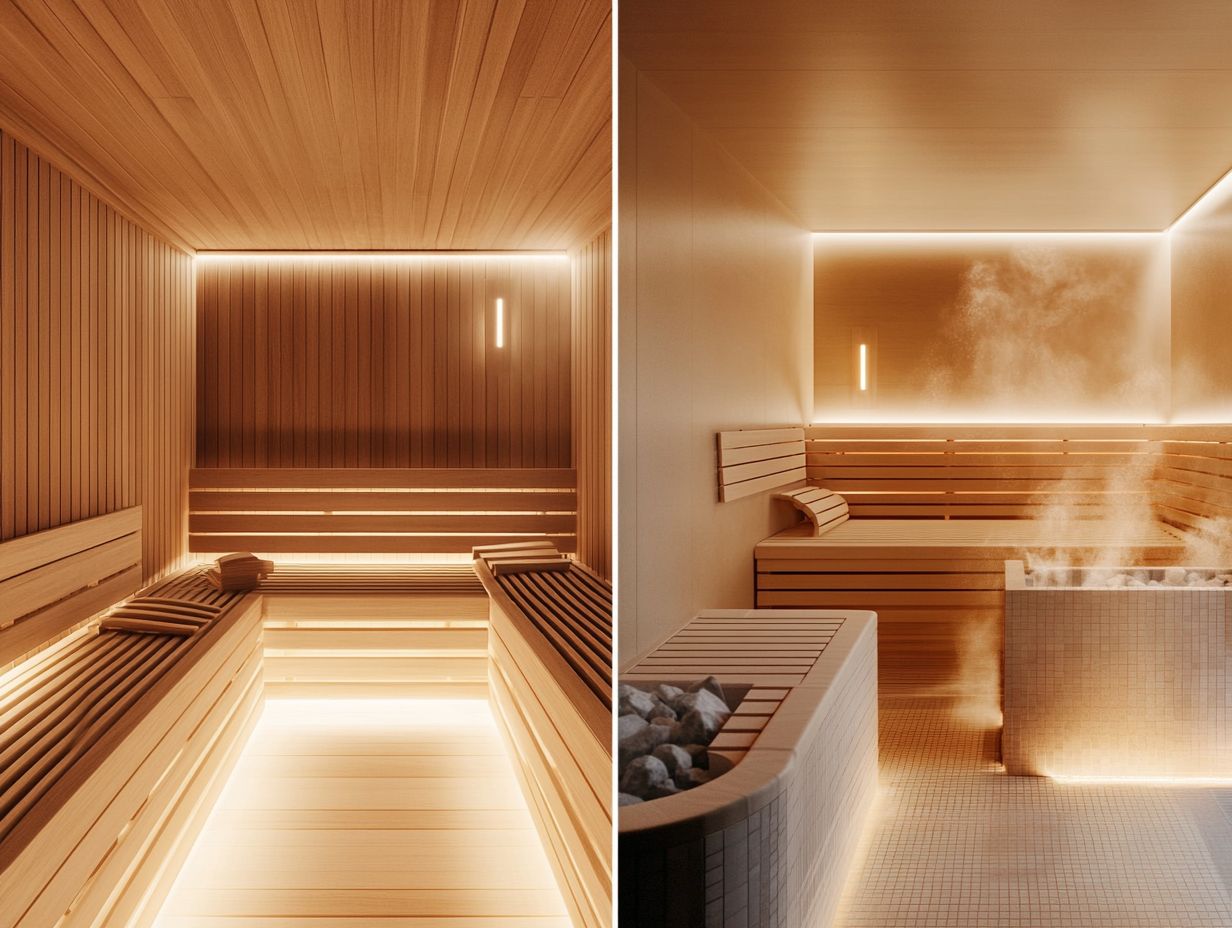Exploring the Benefits of Dry Vs. Wet Saunas
When it comes to relaxation and wellness, saunas stand out as a popular choice. But did you know there are two main types dry and wet? Each type offers unique benefits tailored to different preferences and health goals.
This guide explores the key differences between dry and wet saunas, highlighting their individual health benefits and providing guidance on how to select the right one for you. Essential safety measures will also be discussed to ensure a safe sauna experience.
Whether you re a seasoned sauna enthusiast or a curious newcomer, you ll find valuable insights here that cater to your needs.
Contents
- Key Takeaways:
- Dry Saunas vs. Wet Saunas
- Benefits of Dry Saunas
- Benefits of Wet Saunas
- Choosing the Right Sauna for You
- Precautions and Safety Measures
- Frequently Asked Questions
- What is the difference between dry and wet saunas, such as Turkish baths and Finnish sauna?
- What are the benefits of using a dry sauna, such as infrared saunas?
- What are the benefits of using a wet sauna for your skin?
- Which type of sauna is better for detoxification and sweat therapy benefits?
- Are there any specific health conditions that benefit from dry saunas, such as heart disease and asthma?
- Are there any risks associated with using saunas, such as dehydration and overheating?
Key Takeaways:

- Dry saunas offer a more intense and dry heat, which can help with detoxification, relaxation, and pain relief.
- Wet saunas, also known as steam rooms, use higher humidity levels to promote respiratory health, skin health, and stress relief.
- When choosing between a dry or wet sauna, consider your personal health goals, preferences, and any potential safety precautions to find the best fit for you.
Dry Saunas vs. Wet Saunas
Understanding the differences between dry saunas and wet saunas enables you to make a well-informed decision about your sauna experience. Dry saunas are often found in spas and wellness centers, operating at elevated temperatures with low humidity levels.
On the other hand, wet saunas, or steam rooms, embrace high humidity, creating a distinctly different atmosphere that can influence your cardiovascular health, skin vitality, and overall relaxation. Each type presents unique benefits, but understanding their differences is essential for optimizing your sauna sessions. Additionally, exploring the environmental benefits of saunas can enhance your overall experience.
Understanding the Differences
The primary distinction between dry and wet saunas lies in the humidity levels and how heat is delivered to your body.
In a dry sauna, temperatures can reach a scorching 150 F to 195 F, with humidity levels typically dropping below 20%. This combination promotes an accelerated sweating process that detoxifies your skin and opens up your pores.
The dry air provides an intense, penetrating heat that can elevate your heart rate and enhance circulation, giving you a cardiovascular boost similar to light exercise.
On the other hand, wet saunas, often known as steam rooms, boast a much higher humidity level, usually around 100%. This creates a soothing, moist environment designed for relaxation and respiratory relief. This type of sauna is particularly advantageous if you suffer from respiratory issues; the steam can alleviate sinus congestion and improve airflow.
Benefits of Dry Saunas
Dry saunas present a wealth of health benefits, making them an excellent option for anyone looking to unwind and recuperate. Regular visits can enhance your cardiovascular health by improving blood circulation and supporting optimal heart function.
You’ll also find that they contribute to better skin health, facilitate detoxification, and promote muscle relaxation especially advantageous for those dealing with chronic pain or recovering from intense workouts.
From alleviating stress to helping in the prevention of heart disease, the advantages of dry saunas are thoroughly documented and well worth exploring.
Physical and Mental Health Benefits

The physical and mental health benefits of using a dry sauna are extensive and well-documented.
Numerous studies highlight that when you indulge in regular sessions, you can experience improved blood circulation, enhancing oxygen flow throughout your body. This not only promotes muscle relaxation but also alleviates pain.
The heat exposure in a dry sauna helps your body release happy hormones, often resulting in reduced stress levels and an uplifted mood.
Research featured in the Journal of Clinical Psychology backs this up, revealing that individuals who weave sauna therapy into their routines frequently report lower anxiety levels and heightened emotional resilience. Moreover, frequent sauna use is linked to improved cardiovascular health and a decreased risk of certain diseases, positioning it as a holistic approach to overall well-being.
Discover which sauna is right for you and unlock its benefits today!
Start your wellness journey now with the right sauna experience!
Benefits of Wet Saunas
Wet saunas, often referred to as steam rooms, present an array of distinctive health benefits, especially for those dealing with specific health conditions. The combination of high humidity and elevated temperatures in a wet sauna promotes cleansing by encouraging sweating, a natural process that helps eliminate toxins from the body.
This humid environment also hydrates the skin, making it an effective solution for skin conditions such as psoriasis and eczema. Wet saunas also strengthen the immune system, rendering them a wise choice for individuals dealing with asthma or other respiratory concerns. Additionally, exploring the benefits of public saunas can enhance your overall wellness experience.
Physical and Mental Health Benefits
The physical and mental health benefits of wet saunas are truly remarkable, especially when it comes to promoting relaxation and recovery.
By harnessing wet heat, these saunas create an atmosphere that enhances your body’s natural cleansing processes, allowing you to expel toxins through sweat effectively. Research shows that regular use can significantly strengthen your immune system and help to reduce the frequency of colds and infections by stimulating lymphatic circulation. For more insights, check out saunas: a natural detox solution.
Wet saunas offer a sanctuary for stress relief, where the soothing warmth calms your mind and lowers cortisol levels, the notorious stress hormone. Engaging in this therapeutic practice not only aids in muscle recovery after exercise but also nurtures a sense of well-being that can enhance your sleep patterns and overall mental clarity. For more insights, explore the benefits of proper sauna usage.
Choosing the Right Sauna for You
Choosing the right sauna can transform your health journey. Consider the type of sauna that appeals to you do you thrive in the intense heat of a dry sauna, or do you prefer the soothing humidity of a wet sauna?
Reflect on your personal health conditions and goals, whether it s recovering from muscle strain or addressing skin health concerns. Don t overlook the distinct advantages of infrared saunas, which use light to create heat, promoting relaxation and health benefits.
Factors to Consider

When you’re selecting a sauna, there are several important factors to consider to ensure it aligns perfectly with your needs and health goals.
First, think about your temperature preference and humidity levels. If you find traditional saunas too intense, you might appreciate an infrared sauna, which operates at lower temperatures and offers a more comfortable experience. For more insights, consider exploring the health benefits of infrared saunas. Steam saunas provide a moist environment that can be particularly beneficial for respiratory health, while dry saunas deliver a more intense heat experience for those who prefer it.
Finally, take into account any specific health conditions you may have, such as cardiovascular issues or skin sensitivities. Different sauna types offer varying therapeutic benefits that could significantly impact your well-being. For instance, exploring the benefits of herbal saunas can provide insights into options that enhance relaxation and support your individual health objectives.
Precautions and Safety Measures
Grasping the essential precautions and safety measures when using a sauna is crucial for maximizing health benefits while minimizing any potential risks.
What to Know Before Using a Sauna
Before stepping into the soothing embrace of a sauna, it s essential to grasp a few key precautions that will ensure your experience is both safe and rewarding.
Start by keeping yourself well-hydrated; drinking water before, during, and after your session is crucial since dehydration can lead to dizziness or even more severe health concerns. If you have heart conditions or blood pressure issues, consult your doctor before using a sauna. Exploring sauna therapy and its holistic health benefits can also provide valuable insights.
Embracing recommended sweating techniques is another smart move. Gradually acclimating your body to the heat and limiting your sessions to 15-20 minutes will help you reap the full benefits of this wellness ritual while keeping potential risks at bay.
Frequently Asked Questions
What is the difference between dry and wet saunas, such as Turkish baths and Finnish sauna?

Dry saunas use heated rocks or infrared heating elements to produce heat. In contrast, wet saunas create a humid environment by using steam.
What are the benefits of using a dry sauna, such as infrared saunas?
Dry saunas help relax muscles and improve blood circulation. They can also assist your body in getting rid of toxins when you sweat.
What are the benefits of using a wet sauna for your skin?
Wet saunas offer great advantages for skin health. They improve respiratory conditions and boost skin hydration!
Which type of sauna is better for detoxification and sweat therapy benefits?
Both dry and wet saunas can help with detoxification. However, the high heat and humidity levels in wet saunas may lead to more intense sweating, enhancing muscle relaxation and stress reduction.
Are there any specific health conditions that benefit from dry saunas, such as heart disease and asthma?
Dry saunas can be beneficial for people with arthritis, chronic fatigue syndrome, and fibromyalgia. They help relax muscles, improve circulation, and promote cardiovascular health.
Are there any risks associated with using saunas, such as dehydration and overheating?
Some risks include dehydration and overheating. They may also aggravate certain conditions like existing cardiovascular issues. Always consult with a healthcare professional before using a sauna, especially if you have preexisting health conditions, or are considering infrared or Himalayan salt saunas.






